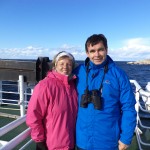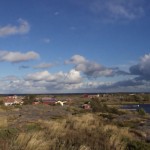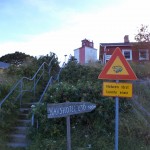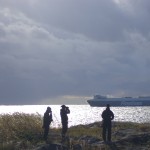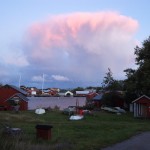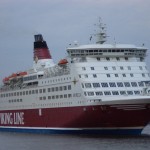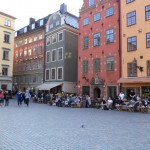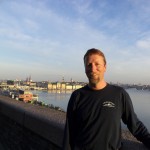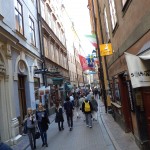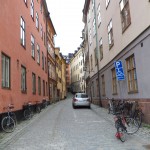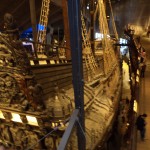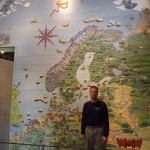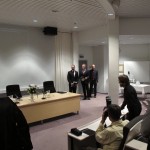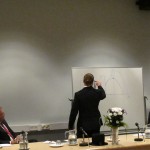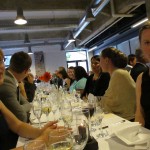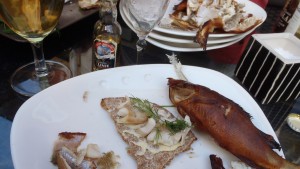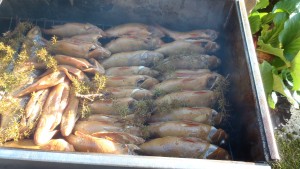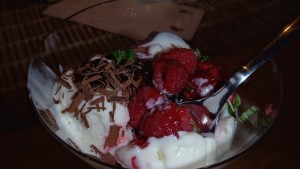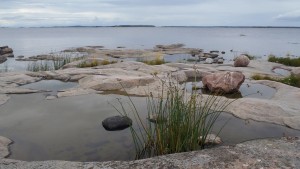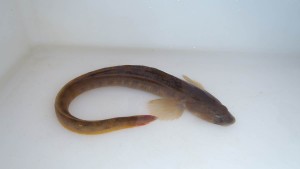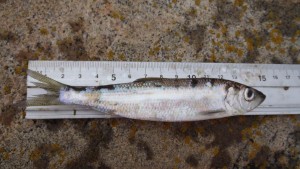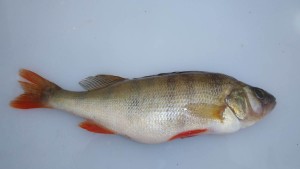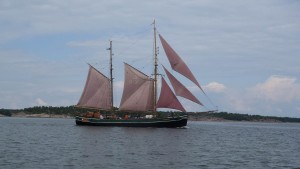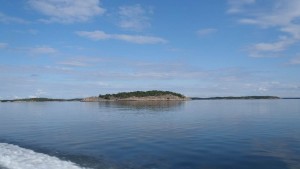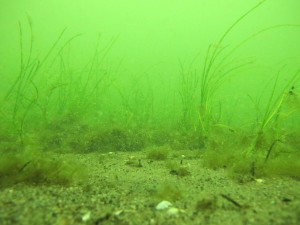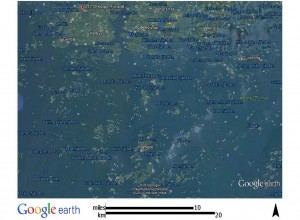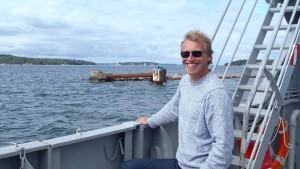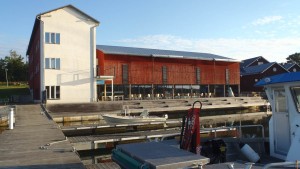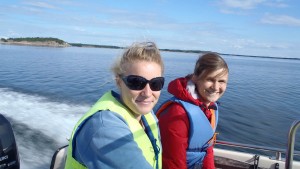Kayaking in the Archipelago Sea
by Paul Richardson (VIMS technician)
The weather is beginning to warm here in Virginia, which means that soon I will be able to dust off my kayak and take it for a paddle in the nearby York River. The last time I went kayaking was over the summer when I was in in Finland. While there I was fortunate to have two wonderful and very hospitable neighbors in Korpoström, Heidi Arponen and Kevin O’Brien, who work for the Finnish Forestry Service known as Metsähallitus (Finnish), or Forststyrelsen (Swedish). In addition to taking me to lunch, having me for dinner and sharing many cups of tea, Heidi also invited me to go sea kayaking in the Baltic on her her SKUK Explorer. It was amazing. Heidi and Kevin mounted a GoPro camera on the front of my boat so that I can share the experience here. The GoPro took a still every 5 seconds. I hope you enjoy this virtual tour of the Baltic.
Exploring Finland’s Outer Islands
by Paul Richardson (VIMS technician)
If you’re ever in the Archipelago Sea of Finland, then you must visit the outer exotic islands. I took advantage of a few slow days before the experimental breakdown to take an overnight trip to Utö Island on one of the free boats that make regular rounds of these islands. Utö is an island on the outer archipelago with a town, a light house and an old military base that was used in battles with the Russians and others.
The boat I took, the M/S Eivor, is a refurbished Norwegian fishing vessel that is very sea worthy. It has a nice cafeteria, inside benches and seats and, my favorite part, the open air upper deck that is three stories above the water with diner style benches and tables.
The boat passed and stops at many islands along its five hour trip. It is nice to see all of the islands, but if you get off of the boat, you will be left until the next day. So, it’s good to bring an overnight bag for this trip and it’s also preferable to contact people ahead of time at whichever island you choose. I contacted Hanna Kovanen at Utö Island. She, like most everyone else that I met in Scandinavia, speaks fluent English. She’s very nice, and she’s a native of the island. When she was younger she went to California for a foreign exchange program. Hanna is a very bright multi-tasker in that she served as my tour guide, hotel clerk, and chamber of commerce minister once on the Island. The tour of the lighthouse was 6 Euros and my room was 25 Euros. As I said, the boat ride is free so this is a very inexpensive trip. Who said Scandinavia is too expensive to visit?
While on the boat I made some new friends, Antti and Tuula Karlin. Antti is an orninthologist and Tuula is a school teacher. They are native Finns. Antti was very surprised to meet an American and, like some others in Finland, he referred to me as “exotic”! Overall, my experience was that most Finnish people who speak English love to talk to Americans (like me!) and they’re all extremely kind. The Karlins were no exception and I genuinely enjoyed chatting visiting with them. We exchanged emails and we’ve been trading pictures and information ever since.
One interesting fact about Tuula is that she “collects” swimming holes. She goes swimming all over Scandinavia and other places, despite the temperature. She keeps a swimming journal with her collection of sites. When I saw her on the boat ride back on the next day she informed me that she went swimming at Utö. Meanwhile, I was wondering whether my sweater, long johns, hat, and jacket, were enough clothes for the frigid air temperature! Boy, I’m such a wimp when it comes to cold water!
Utö Island
I spent the night on Utö Island. It’s one of the outer most islands of the archipelago. It has a very rugged beauty and is steeped in a rich history. On the island there is an old military base, some weather stations, fishing shacks, plenty of beautiful vistas, a 19th century lighthouse and lots of history. The lighthouse that stands there now was built in 1814 – the original light house built in 1753 was blown up in the Finnish war. The island even has its own endemic toad. What they don’t have are ticks. Nice!
Connection to the United States
On Christmas Eve in 1947 a United States ship, the SS Park Victory, was just off of the Utö lighthouse trying to maintain its position in the icy waters when its boiler exploded and blew a hole through the side of the ship sinking it. Ten of the 148 men died and the other 138 were rescued by the people of Utö. They took them into their homes and gave them shelter and food. This was recognized by the U.S. government on at least two separate occasions and the letters are framed on the wall of the chapel in the lighthouse.
According to Hanna, this was the first time that the people of Utö ever saw a black person. According to personal accounts that Hannna referenced in her tour, there was some confusion among the black sailors when they entered the houses and found that there were no segregated tables where they could sit. This also created confusion for the citizens of Utö! Needless to say, all of the survivors were seated at the same tables. Hanna also indicated that she is related to one of these black survivors.
Off to Stockholm
The next day I got on the much larger (cruise ship size) M/S Isabella, which is a Viking Line “ferry” that carries some cars and mostly pedestrians from Turku to several ports at various locations within the 10 nations that border the Baltic Sea. My boat was headed to Stockholm, Sweden. It’s a pretty sweet deal, really. I paid 70 Euros for a round trip ticket. The ship picked me up at 8pm on Monday night in Turku. Once on board, I dropped my bag off in my cabin which was very nice with a private bathroom and fresh sheets. I then checked out the restaurants, casinos, discos, and the huge mall-like tax free shopping center, and then I went to bed. I’d walked all over Turku all day and so I was quite tired.
I awoke at 7am when the ship was approaching Stockholm. It amazed me how close the ferry went to the rocky shoreline. At several points, I could have easily tossed a baseball onto someone’s summer cottage. The ferry docked shortly thereafter and I had the whole day to explore Stockholm and I didn’t have to be back to the boat until 8pm. I walked all over the city. I inquired about the buses and trains and water taxis, but I chose to see a city on foot. Taking it slow allowed me to really see lots of cool details that I would have missed on the bus.
Stockholm is a very old, very beautiful capital city of 870,000, located on 14 islands in the south east of Sweden. The first thing that I noticed was the beauty. The second thing that I noticed was that there were literally more bikes than cars. There were so many of them flying down the hill as I walked into the old town, that I actually felt safer crossing the automobile road with its crossing lights than I did crossing the bike lanes! But I think it’s great! In the States, it’s the opposite. We have the tyranny of the automobile and good luck if you commute by bicycle.
I don’t have the data here to back it up but qualitatively, I’m sure that the Finnish and the Swedes are more physically fit than my fellow Virginian Americans thanks in part to the higher prevalence of bicycle usage. I didn’t drive a car for my entire 40 days in Scandinavia and instead rode a bike or walked, which is probably the reason that I lost 10 pounds during the trip. It was high school the last time I weighed so little!
The city was lovely and the main activity that I did while there, aside from eating and walking, was my visit to the Vasa museum. The Vasa is a one of a kind attraction. In 1628, the king of Sweden, Gustavus Adolphus, in his haste, launched the state of the art warship, Vasa to send to Poland to fight in some Catholic Protestant battles. At 226 ft long and 172 ft tall with 36 guns (twice the recommended amount) and fatefully, not enough ballast, the top heavy vessel floundered and sank near her railway on her maiden voyage. In the absence of ship worms and the presence of anoxic conditions resulting from the pollution in the harbor, the ship was nearly perfectly preserved.
In 1961 archeologists knew that the Vasa laid somewhere in the harbor and so they started taking cores of the sediment to see if they could get a plug of some white oak which is the wood that the Vasa was made of. After many attempts, they finally located and excavated her. Using SCUBA and some type of fire hose pump they insert several harnesses under the hull and ultimately hoisted the behemoth, nearly intact, to the surface. They’ve been restoring her ever sense.
The thoroughness of the museum was simply mind boggling. I spent three hours there and I could only scratch the surface. It is six stories from the keel to the top deck. They had to replace all of the water in the wood with polyethylene glycol. There were skeletons of the people who were on board and perished in the disaster. There were models, and maps and MRIs of the hull. In some ways it almost resembled a modern ship yard with lifts and heavy equipment and restorers flitting around working. There were so many exhibits with artifacts that it was overwhelming. By 1pm I was quite hungry and I needed to see sunlight again. I had intended to get some food and return, but when I went outside it was so beautiful that I vowed not to go into any more museums! I spent the rest of my day in Stockholm sightseeing and taking tons of pictures. Towards the latter part of the day, close to the time when I would catch the ferry, I went from pub to pub trying various delicious food and beverages.
As I got on the ferry in Stockholm on Tuesday night I received a phone call from Christoffer. He wanted to warn me that I must come directly to the lab and prepare for the field on Wednesday as soon as I got back from Turku. We would go to the field that afternoon and begin the ZEN breakdown since there was very bad weather predicted for Friday. My mini-vacation was over and it was time to get back to work on this last phase of my involvement with the ZEN project in Finland.
A Dissertation Defense, Finish Style
by Paul Richardson (VIMS technician)
After many years of graduate school, students are expected to defend all of the work they’ve done before they receive their degree. Doctoral defenses in the States are pretty intense and generally consist of a public lecture followed by public and private questioning session that can last for hours. I’d been told that European defenses can be much more elaborate and so, when I heard that one was scheduled for a Finnish student here at Åbo Akedemi I decided that I must go! Camilla, a graduate student here helping with the ZEN work, invited me with the instructions to bring my dress pants and dancing shoes. And my new Swedish language skills as the defense would not be in English. So, I woke up early and rode my borrowed bike in my dress pants with my backpack the 10 km to the little town on Korpo Island to catch the bus for the two hour ride to Åbo Akedemi’s Bio City in Turku.
Once I got to Turku I went to the Domis, which is Åbo Akademi University’s housing for guests. The Domis is a very Spartan grey concrete institutional building with more locks that Fort Knox (a military base in the USA). Once I penetrated the outer perimeter I met the very friendly Anita Bruman Tott who checked me in. One of the first things I recall her asking me was, “hey, are you the TV guy?” I guess my cameo on the Finnish TV talking about seagrasses has made me slightly famous here!
The fee for staying at the Domis was quite reasonable at 30€. It turns out the room was just as Spartan as the rest of the building and the bathroom was a little cramped, but the bed was very comfortable, the view was pleasant, and later that night, I slept like a baby.
Since the defense was a formal affair, I recognized that I was grossly underprepared in the wardrobe department The only suit I’d brought with me was my wetsuit and, despite the fact that we are marine ecologists, showing up to the defense salty and smelly probably wasn’t the best way to go, even if it would have been funny (and uncomfortably hot!). Christoffer let me raid his closet and I came up with a tie and a slightly too small sport jacket. In need of a dress shirt, after checking into Domis I went straight to the mall. The salesman had a good laugh when I came out of the dressing room with the brand new shirt on (with all of the tags still attached) under the tie and sport coat. He cut the tags and rang me up.
All dressed up I headed downtown toward Bio city, grabbing a snack along the way as I had been warned that the defense would take several hours. Realizing that the defense would be starting soon, I picked up the pace. Camilla called me and, after asking where I was, told me to quickly get on a bus as I wouldn’t make it in time. They are very punctual here in Finland and if I was even a minute late I risked being locked out of the “proceedings!” So, I backtracked quickly to a bus stop and crossed my fingers that the first bus I hopped on was the most direct one to the university.
Thank goodness for the effective mass transit of Turku! , I made it just in time. The door closed right as I sat down. Right away, three well groomed gentlemen walked inside wearing very nice suits – one even had a top hat! Everyone in the auditorium stood. We stayed standing until someone gave a signal to sit and everyone sat in unison. I started to wonder – is this a dissertation defense or a court of law? Cameras started clicking away, preserving this momentous occasion, and so I went to get mine. That’s when I realized that I’d left it on the bus! That was bummer. Luckily Camilla had a camera and shared her photos with me.
Before I forget, the student defending his defense was Matias Scheinin. His advisor, Johanna Mattila, was wearing the top hat. The third gentleman was the “challenger,” an external reviewer flown in to test the student’s knowledge, from Sweden, Peter Eklöv.
After introductions, Matias launched into the formal hour-long presentation of his work on the “Patterns and processes of littoral zooplankton composition in relation to the trophic state of the environment.” The defense was in Swedish, but luckily for me, the presentation slides were in English. His work on the zooplankton ecology of the Baltic was very interesting. One of his experiments involved natural mesocosms, which consisted of coves in islands (called flads) that had varying communities with varying levels of predation by different fishes including roach (Rutilus rutilus) and perch (Perca fluviatilis). The take home message from that experiment for me was that differences in vegetation (presence or absence of submerged aquatic vegetation) affected the feeding rates of perch, but did not affect roach feeding. I’d seen a lot of roach around the docks at the field station, so it was very interesting to learn more about their ecology.
After the formal presentation the challenger, Peter Eklöv, critiqued Matias’ dissertation for the next two and half hours in front of the entire audience! This was very different from the defenses I’d seen back in the States where the professors grill the student in a closed door session after the public presentation. All of the interrogation was in Swedish, so it was difficult for me to follow. Eventually the whole thing was adjourned and we went to begin the celebrations – Matias had passed the exam and was now going to be a PhD!
In close vicinity to the auditorium the toasts began. In English we say cheers, but in Swedish they say skål (pronounced skole or skull). Then everyone dispersed and met back at the reception hall a few hours later. At the reception there was another toast outside in the lavish entry lobby and then, once again, the well-dressed crowd walked in and stood behind their chairs until given the signal to sit and the toasts resumed. Then there was an introduction to the buffet menu, which included rostad sik med pepparratssmörsås och honungsrostad rödbeta (roasted whitefish with peppercorns and honey roasted beetroot) for the main course and a wonderful äppelpaj med kardemummås (apple pie with cardamom) for dessert. Dessert was served with a selection of Scotch whiskies and cognacs and coffee, plus many more toasts, roasts, skits and power point presentations. Matias experienced a thorough hazing, all in good humor of course.
After dinner Matias’ brother-in-law and his all physician rock band played many great tunes ranging from the Rolling Stones, to Parliament, to Alanis Morrissette interspersed with very good Finnish rock songs (I couldn’t understand the words but they totally rocked!). Ultimately things wound down around 1:30 AM . While the others headed off to the “after-party” celebrations, I carried my old bones back to my Domis room to sleep.
Embracing local language, food and traditions in Finland
by Paul Richardson (VIMS technician)
Language and Culture
Before arriving, I didn’t realize that 75% of the people here speak Swedish and not Finnish. I’ve heard it can be a problem for kids who don’t learn Finnish when they go to find work in the city. One thing that is lucky for me is that most everyone speaks English. However, I usually have to warn people or they will assume that I speak Swedish. Apparently my Scandinavian heritage lets me blend in well here in Finland. Anyhow, I’m learning a few basic phrases and I even conducted an entire transaction at the grocery store the other day without speaking any English! Gå Svenska! (Go Swedish!)
A common language – food
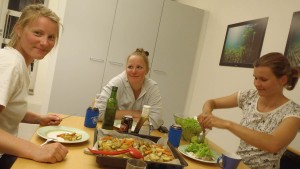
After a hard day of fieldwork, Paul relaxes by cooking a delicious meal with the graduate students working on the ZEN project in Finland
I’ve been able to practice my Swedish and Finnish both when visiting the home of the Boströms, my wonderful hosts here in Finland. Three times now the Boström’s have invited me to their lovely country home for some of the most amazing meals! The first one involved a “pastry” with chanterelles. I would equate it to a much enhanced quiche. It was amazing. I should also mention that they always also have an amazing assortment of cheeses, meats, olives and crackers as hour’s devours regardless of the main course. Talk about host hospitality!
Then the other night, in a pure Norwegian tradition, we smoked some perch and white fish in the most amazing way. Chris has a smoking box that he put aspen wood chips and sugar cubes into the bottom of. I brought some gutted and salted fishes that we put into the box on a grate over the wood chips. Then Chris put juniper sprigs on top. Then he put the smoking box onto a wood fire for about 40 minutes. The result was amazing. You then take a fish and break it in half, revealing the entire skeleton which is then easily removed. With it they served a crunchy brown bread that we put butter, the fish and then sprigs of dill onto. This was served with beer and Norwegian anise liquor that was simply to die for. I had visions of Vikings as these delicacies melted in my mouth on their lovely patio.
After every meal, the Boström’s always have some wonderful dessert. With the fish it was a humungous and delicious blueberry pie a la mode, and after the chanterelle pastry it was just the ice cream but it had Finnish chocolate shavings and they made on the spot a sweet sauce with fresh raspberries, blueberries, and (I never would have guessed it) basil! Oh my goodness! I never realized before coming to Finland what wonderful culinary treats I would be in for.
Embracing local traditions – the polar bear plunge

Paul’s face right after he came up from his first “polar bear” style plunge into the frigid Baltic Sea without a wetsuit!
One Saturday while on a nice bicycle that Minna and Christoffer’s friend loaned to me, I got a flat tire about 10 km from my home base at the lab in Korpoström. I walked back and so I was pretty tired and ready for a beverage when I quickly checked my email first. Out of the blue Christoffer had emailed me to tell me that my trip to Finland would not be complete without doing two things: first, jump into the Baltic (without a wetsuit) and next go sit in a sauna, with a few beverages in between. It was such a niec day I thought, what the heck! I did 4 cycles of this. I think they call it a polar bear plunge or something like that back home. Wow, 16oC water will really remind you that you’re alive! I won’t say it was nice, but it certainly was invigorating! Marie later told me that many of the locals do it in the dead of winter by cutting a hole in the ice. I think I might be a little too wimpy for that. But, give me a drysuit and some mesograzers to catch and I’m your man.
The Natural Beauty of the Archipelago Sea
by Paul Richardson (VIMS technician)
ZEN-like surroundings in the Archipelago Sea
The Archipelago Sea is like no other place that I’ve ever been. It’s completely different from the Spartina mud flats and warm eutrophic waters that I’m used to in Virginia. The glacier scoured bedrock islands go on forever. They are mostly granite with a variety of low vegetation and trees. The trees are usually small, some approaching bonsai status. I’ve seen fully mature miniature pine trees growing in a very limited amount of soil that collected between a few rocks. Also stunting them are the arctic winds and sea spray that blast them incessantly.
On the outer islands trees are absent altogether. But, these short sometimes bonsai trees and the lichen encrusted bedrocks remind me of what we have in the Appalachian Mountains but instead of being at 900 meters elevation, it’s all essentially at sea level. Unlike the small muddy islands of the coastal plain in the lower Chesapeake Bay, these rocky islands were created by glaciers and they’re are all rising due to the rebound of the land after the glaciers retreated. The average rebound is about 8mm per year! At this rate, sea level rise will not submerge these islands. In fact the curator of a local museum told me that he knows people who are frustrated with places where once viable waterways are now fields. We have the opposite problem in the Chesapeake region, where the islands are sinking and ultimately disappearing. The islands of the Baltic also hold many surprises in the form of Japanese ZEN water features. You can never create a more beautiful water feature than can nature.
More Baltic to Chesapeake Comparisons
To better visualize the extent of the Baltic I like to compare it to the estuary that I know so very well, The Chesapeake Bay. The Baltic is a much larger estuary. It is over 5 times as long at 1600 km whereas the Chesapeake is 300 km. The Baltic has an average depth of 55m whereas the Chesapeake has an average depth of 14m. The area of the Baltic, at 377000 km2 is over 30 times that of the area of the Chesapeake at 11601 km2. But most striking to me is the difference in the salinities between these two bodies of water. Having a relatively broad mouth and a shallow basin the Chesapeake has a much higher salinity of about 20 psu in the lower portions, whereas the Baltic with its narrow strait has a much lower salinity of 6 – 8 psu. However, in the deeper holes in the Baltic, there are super stratified salty “basins” that are anoxic and harbor huge sulfur communities.
So even though both systems have Zostera marina and the epifaunal grazers are similar, there are vast differences in much of the fauna between the two estuaries. The Chesapeake with its extreme temperature variation, wide open mouth, and saltier water has many more transient marine fishes that change with the seasons. The Baltic is more of a closed system with salmon, pikes, cyprinids, and perches (see the pictures to the left of some of the fish I caught at the ZEN site here in Finland). Similarly, however, in the eelgrass beds, both estuaries have gobies, pipe fish, sticklebacks and blennies.
Pack Ice
In contrast with the Chesapeake, here in the Baltic researchers have to contend with pack ice, which forms in November and lasts until early spring. Christoffer told me that every five or so years the ice freezes so thick that ice experts assess and plow it and make designated official roads to accommodate the transport of supplies such as building materials to islands in a way that is much more efficient than by boat (think Ice Truckers). I’ve seen ice on the Chesapeake, but it has never been thick enough to drive a truck on, much less walk on! Chris also said that if it’s calm and it doesn’t snow, then some of the most amazing ice skating conditions will occur. Too bad I head home before the cold weather sets in.
Traditional Wooden boats
During the summer time, however, boats are still the most common means of transport among the islands. I’ve noticed that in addition to the more commercial ferries, there are a lot of traditional wooden boats in the Archipelago Sea. It’s an art that has returned in recent years. Many people are restoring the old wooden boats, including Christoffer! He has several including a 7 meter Swedish racing boat that he restored and maintains. He purchased it when he was a graduate student so that he and his wife Minna (who’s also a research scientist) could get away when they had a break from their studies. Purchasing an island on a graduate student income was out of the question so they got this lovely wooden boat.
The Changing Baltic Sea
Temperatures are dropping, we’re having more storms, days are getting shorter, and fall is almost here. Summer, it seems, was over in a day. There will be more posts on the sporty conditions that we’re beginning to experience and will be experiencing more often with the changes in the seasons. To be continued as ZEN 2012 in Finland marches on!
(Wet)Suiting up for research
by Paul Richardson (VIMS lab technician)
The Experimental Site
Just barely over my jet lag, we recently set up the main ZEN experiment at the Fårö Island eelgrass meadow in about 3 -4 meters of water a one hour boat ride from the field station in Korpoström. Unlike the warm shallow waters of the Virginia grass beds, all of the work was done in SCUBA with dry suits by Camilla, Anna and Christoffer. I assisted from the boat or in my 7mm wetsuit with snorkel gear.
The plots were staked out with short galvanized rebar rods instead of the PVC poles that make up our “pole gardens” in Virginia. For marking tags they ingeniously employed cut squares of linoleum flooring tabs. The site perimeter is marked by small buoys. Because the water is so deep at the field site, there is no worrying that a small boat will run over the plots.
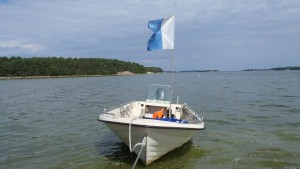
The research vessel used by the ZEN team in Finland. Note the blue and white dive flag. In the U.S.A., red and white flags are used to alert that divers in the water.
Witnessing the huge addition of logistical effort to conduct the ZEN work in deeper water with SCUBA and especially dry suits gives me a new appreciation for what the ZEN partners working at deeper subtidal sites have to do to get the job done. Everything takes at least twice as long. The work and general communication is more difficult. Work is limited by the air in the tanks, bottom time, and general fatigue. Once the work is done and everyone is out of their dry suits, they can’t just jump back in the water and fix something if needed. It usually takes another planned trip.
Algal Blooms!
Further complicating matters is the fact that the usually clear waters of the field site (see pictures from the 2011 experiment) have been clouded by a senescing blue green algae bloom that leaves the water full of chunks of a green, snot-like substance that you don’t want to swallow – apparently it is hazardous to your health. Also, the eelgrass beds are covered with a matrix of algae that are dominated by the frilly Ectocarpus. Otherwise, the eelgrass blades themselves are beautiful, green and covered with very few epiphytes. But these Ectocarpus mats are so thick that in places they go completely anoxic and turn white. We see similar effects during certain times of the year in Virginia where large blooms of the green algae Ulva and red Gracilaria drift in and smother the eelgrass in the Chesapeake. Here in Finland there is the danger that if you disturb these mats you can get a shot of hydrogen sulfide that can penetrate right through your skin.
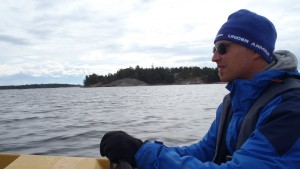
Christoffer Boström navigates the complicated seascape of the Archipelago Sea to the ZEN project site on Fårö Island, Finland.
Also, since the Fårö Island site is about 24 km away it requires an hour long boat ride. With fuel costing 1.63E/L (that’s $6,71/gal) and SCUBA setup and breakdown time, every field trip is a significantly greater investment of time and money than what I’m used to. Field days are usually 15 hour days. But once it’s all done I know it will all have been worth it.
According to the locals and everything that I’ve read, the Archipelago Sea has over 30000 islands! Being the experienced boat captain that I am back in the States, I can say that I won’t even attempt to navigate a boat around here. The gauntlet of islands on the way to the field site is mind boggling. I’ll leave the navigating and boat driving to Camilla, Marie, and Christoffer, who have the local knowledge and skills to safely transport us to and from the field site at Fårö Island.
Finnish News Media!
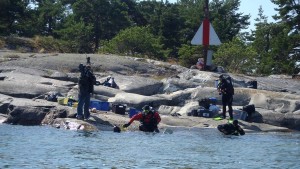
Journalists from the Finnish Nature channel film the ZEN team in Finland as they prepare to setup a large experiment
On top of everything else, we also had a visit from the Finnish news media. Christoffer brought them by boat to our remote field site shortly after the beginning of the work on the 13th. We were each interviewed for the national T.V. news, the radio, and the magazine, Suomen Luonto, which literally translated, means “Finnish Nature.”
It went pretty well, except that I gave the reporter some footage of us working in the grass beds of Virginia and I neglected to delete the audio which I didn’t think would be included, but it was. Also, in my jetlagged state, I mentioned that prior to the human perturbations in the Chesapeake Bay, “there was 90 % more (sea) grass in the Bay,” which, if taken out of context is not exactly correct. The seagrass coverage that we have now is 10% of historic levels. In other words, seagrass coverage in the Bay was historically 900% of current levels! Either way you look at it, that’s a huge and worrisome decline given all the important ecosystem services and functions that seagrasses provide. Media exposure can be good for your cause, but I’m finding it can also be difficult. Anyhow, overall, I think we got the message across that eelgrass meadows are important systems all over the northern hemisphere and that they need to be protected. Check out the ZENscience news page for a link to this story.
Dispatches from Finland: Arrival
by Paul Richardson (VIMS Marine Biodiversity Lab technician)
The Long Journey from Virginia to Turku and then Korpoström
At over 6500km, traveling to Finland was the longest journey I’ve ever made. At 42 years of age I’ve never been out of North America, and traveled only once outside of the United States (a brief ski trip to Canada a few years back). With all of the ZEN research going on at VIMS right up until my departure, I had little time to be nervous for my first true international travel experience. My United flight on a spanking new 757 provided surprisingly good food, and there was a selection of movies. One thing, however, that I really appreciated was the flight monitor where I could see the plane’s progress, its speed, the arrival time (which was always further away than I wanted!), the temperature outside of the plane, etc. Being the irrationally nervous flyer that I am, it was somewhat comforting to know that the altitude was 36000 feet, speed was 580mph, and the temperature outside was -60oF. Sitting upright and cramped, combined with my excitement for the trip, I couldn’t sleep a wink all night.
In Copenhagen I was thrilled to get my first passport stamp. Then I boarded a bus to go across the tarmac to a Scandinavian Airlines flight to Turku, Finland! The plane was pretty empty – the benefit of flying into Turku at the end of the tourist season. Every other seat was vacant, which would have been nice for the trans-Atlantic flight.
During our approach, we flew right over the Archipelago Sea where we are conducting the ZEN experiments in Finland. I snapped a few pictures of some of the estimated 30,000 islands. Despite the cloud cover obscuring some of the smaller islands, it was comforting that the view looked like a more vibrant version of the Google Earth images that I viewed a few days prior.
Stocking Up with Provisions!
Once on the ground in Turku, I was thrilled to find that all of my bags made it through four connections and two airlines half way across the world. I was even more thrilled to find that ZEN collaborator, Dr. Christoffer Boström, was waiting for me just outside the gate. First we went to the City Market in Turku to stock up on food and other supplies before traveling to the marine station on the island of Korpoström . The City Market is amazing. It’s the size of a Super Wal-Mart back home, with a department store and a grocery store, but most of the food and produce is local and luomu (organic). I had no idea what any of the labels said, but Christoffer, a self-proclaimed food nerd, gave me the tour. When he said something was good, more often than not, it went into my cart.
With my blond hair and standing 6 feet tall, I didn’t feel terribly like I stuck out as a tourist until I asked for a grocery bag. Most of the stores in Finland (and I’m told Europe in general) do not give out grocery bags. If you don’t bring one, you have to buy one. City Market generously gave me one – my first welcome to Finland present! The bags are big so I managed to get all of my 100+ Euros worth of food into it. I got many delicious meats, breads, herrings (I love pickled herrings!) and luomu produce – tasty, but food here is not cheap! Cans and bottles have 15 cents tacked onto the price of each so that you can bring them back for 15 cent refunds each. Didn’t we used to do that back in the States?
A Little More on the Subject of Food
The summer in Finland is an amazing time to visit if you’re a food nerd (or foodie, as we say). Because the sun shines for so long during the day, and at a low angle, the produce is extremely flavorful. Carrots and potatoes and other veggies are about half the size of what I’m used to in the U.S., but they are twice as flavorful. You can also go into the woods and pick berries. You’re even allowed to go onto private property as long as you stay at least 300 meters from any dwelling. With long days of fieldwork and lab processing I haven’t exactly had time to go berry picking in the woods, but I have picked a few on the side of the road and I’ve bought more than a few. If you do plan to go berry picking in Finland though, you need to beware of ticks and getting lost. Apparently, more than one berry picker has fallen victim to ticks and their associated diseases or wandered away and never made it home. The good thing about being on a small island like Korpoström where the marine station is located, is that if you do get lost you can always walk until you find the coast and then follow it home.
My New Digs
After the trip to the market, Christoffer and I took a two hour scenic drive and two ferry rides to my new home for the rest of the summer in Korpoström.
Åbo Akademi University’s field station is in Korpoström which is an island in the Archipelago Sea. This facility is a unique melding of modern art, science, and recreation. On one side you have the Strandboden (beach hut) that is basically a hotel with a marina. Then on this side there are the Åbo Akademi labs, offices and my quarters (a modified office). The park service also has some space and there’s a restaurant and a museum. All of this is situated conveniently on the water where our research vessels are located. I’ve been to the restaurant three times and it is delicious, but mostly I cook my own food purchased from the market trip in the little kitchen upstairs. Listening to all the numerous non-English conversations going on at the Strandboden and the restaurant, I still feel like a tourist, very far from home. But, I am slowly becoming accustomed to my new surroundings, and I can definitely spot the tourists. They speak English.
The Finland 2012 Crew
In addition to Christoffer and myself, there are three very skilled graduate students helping out with the ZEN work: Marie Järnström, Camilla Gustafsson, and Anna Törnroos. Anna was here for one week for the set up and to be Camilla’s dive buddy. Camilla is a PhD candidate at Åbo Akademi University who will be defending soon. Marie is Christoffer’s intern and a master’s student of Åbo Akademi; she will leave to continue her studies at the end of August. These gals are all pretty much locals. Among other languages, they all speak Swedish and, luckily for me, they all speak English very fluently. I’m not sure exactly where Cami and Anna are from, but Marie is from the island of Mossaia, which is three ferries to the North West.
That’s it for now – I’ll save descriptions of the field site and the natural history of the Archipelago for my next dispatch.



